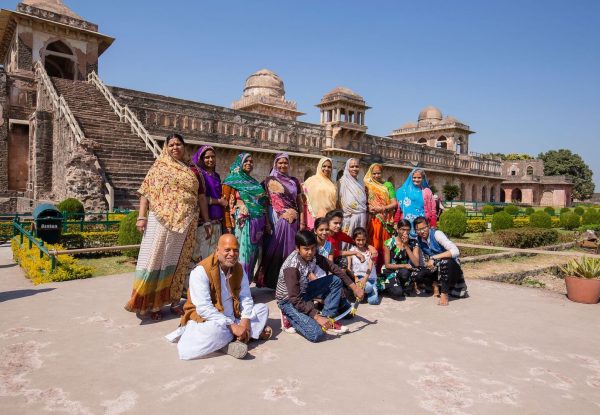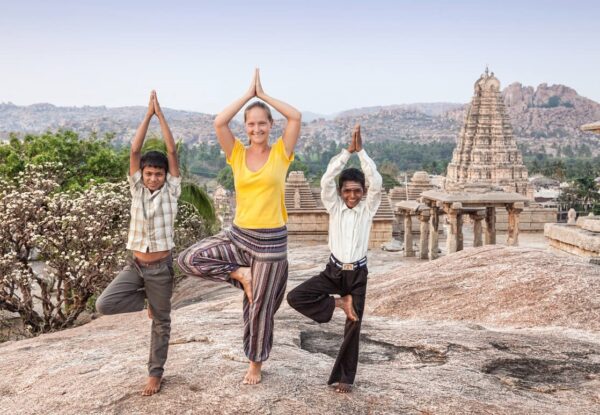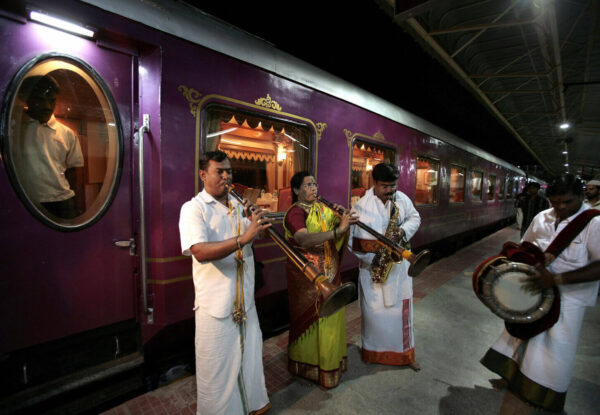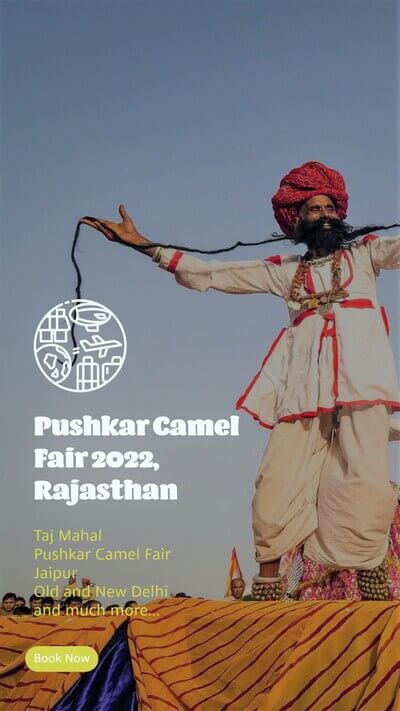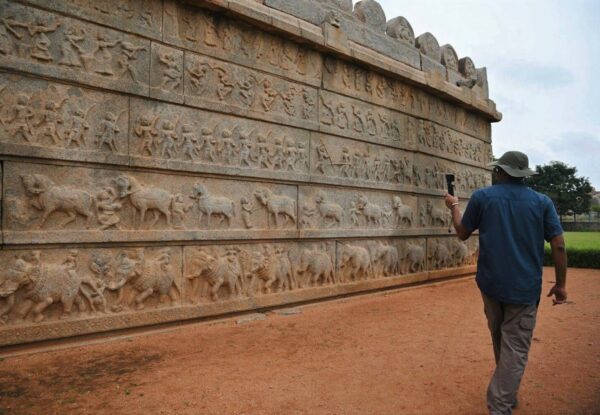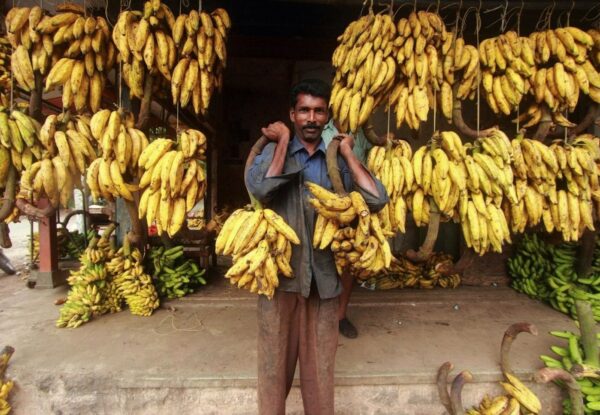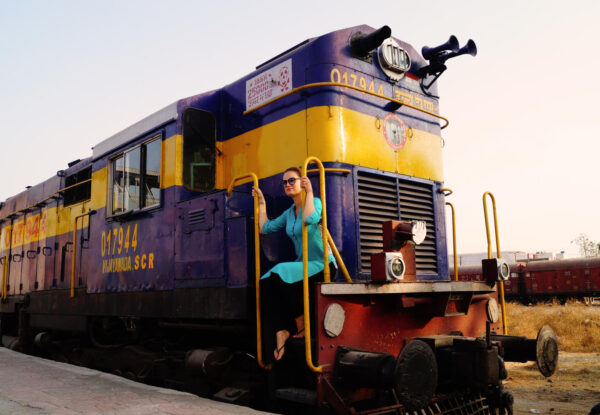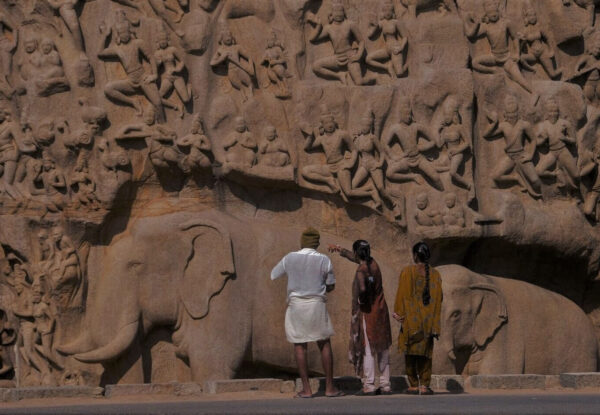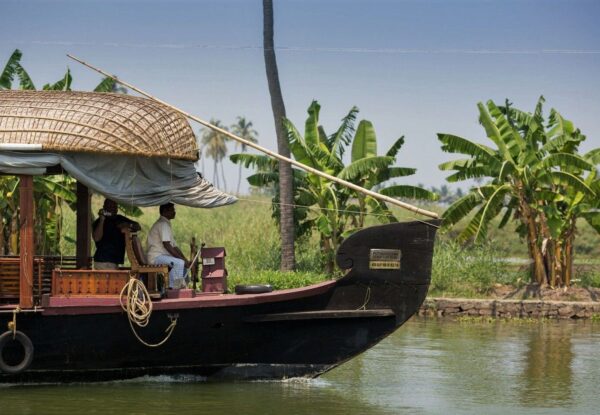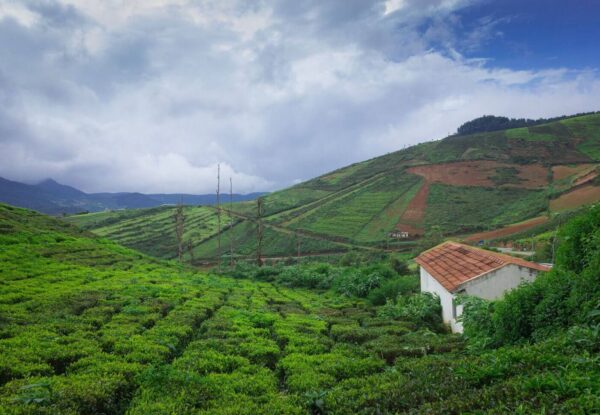- 1 (888) 414-6804 (USA & Canada)
- +91-99274-65808
- info@vacationindia.com
- Effective February 2023, mandatory self-declaration form on Air Suvidha for international arriving passengers has been discontinued. So, no self-declaration needs to be completed by international tourists from any country arriving in India.
- RT-PCR Covid Test NOT required for traveling in India, Nepal, Sri Lanka and Bhutan
- To Travel to India Covid Vaccination also NOT required.
- The use of masks on flights is mandatory. Masks are not required anywhere else in India
India is now open for International Travelers
Guidelines for international travelers (Updated Feb., 2023)
Discounted
Best Seller
Treasures of South India – Best of Tamil Nadu, Kerala and Karnataka (19 days)
19 Days
Keywords: South India Holidays, Holidays in South India
Highlights of the Treasures of South India Holiday
Trip Details
- Experience everything that the South has to offer with our South India Holidayrice on Reques as we take you through a magical journey covering Tamil Nadu, Kerala, and Karnataka
- Southern India is the true reflection of the rich Dravidian culture, most of which is well preserved even today. Your trip to the South will unveil the well-preserved architecture that reflects the penchant for art that the region’s rulers had since time immemorial. You’ll be amazed by the humongous temples ornate with intricate rock carvings that spread across the region. The fact that the Moghul invaders never fully penetrated the southern part of India has meant that, the Hindu and Tamil architecture as well as spirituality has remained free of external influence
- Our South India Tour Package also takes you on a natural exploration covering the serene backwaters of Kumarakom, the pristine beaches of Mahabalipuram and the undisturbed wildlife of Periyar National Park. You will experience the relaxing hilly weather of Udhagamandalam, also known as Ooty. It’s a great experience scaling the mountain on the narrow-gauge train in Ooty, which was once a British summer retreat. People throng the place even today for its beautiful plantations and pleasant weather
- The journey also brings in a touch of spirituality as we visit several sites of Hindu reverence, not to forget the tinge of royalty as we step foot into the royal courtyards of Mysore Palace in Karnataka. Our trip to Karnataka takes us to the architectural wonders of Aihole and Pattadakal. We also take you to renowned Hampi, for which one life isn’t enough to explore entirely. We further visit the temples of Belur and Halebidu amid the Western Ghats as we continue with our Karnataka tour
- We begin our tour with Tamil Nadu where we visit some architectural marvels in Madurai and Chettinad. These structures hold a lot of religious significance to Hindus even today. You also visit Pondicherry, which was once a French bastion in the country. We explore the relics left behind by their colonial rule in Pondicherry
- You will experience a variety of cultures, cuisines, weather and even colors as we travel through the southern region, the visuals of which will remain etched in your memory forever. Your exploration of India is never complete until you’ve seen everything that the South has to offer.
Your exploration begins with your arrival at Chennai International Airport where our representative will be ready to greet you. This is the time when you also receive all your travel documents for your uninhibited travels throughout India. You will be escorted to your hotel first.
As you speed towards your hotel, realize that you’re in the fourth largest city in India. Home to some of the most intelligent brains of the country, this city is a perfect blend of the ancient and the modern aspects of India. You will find Chennai culturally rich with undaunted patronage to classical music and dance as well as monuments and museums, and of course the traditions that have been passed on through generations. There is another face to Chennai which has been in sync with modern development. The high rises, industries and cinema are representative of this facet of Chennai. You spend the day relaxing and getting set for the next day here.
We begin with a guided tour of Chennai, the capital of Tamil Nadu. Our first stop is at the National Art Gallery (NAG), an assortment of 46 galleries. View the timeline of South India here from the times of the royals to the present day. The gallery boasts the biggest collection of bronze statues, mostly from the era of the Chola Dynasty that reigned over southern Indian between the 9th and 13th Centuries.
It’s now time to explore the architectural beauty of Chennai. We begin with Fort St. George, the first British Fort built-in 1664, which stands as a testament to Colonial architecture here. It is home to St. Mary’s Church, which has the distinction of being the oldest Anglican place of worship in the country. You’ll find quite a few relics of the British of that time such as weapons, coins, silver-ware and the like. The Christian imprint on Chennai is not limited to those of colonial times. In fact, Apostle of Jesus, St. Thomas is said to have visited the city around 52 AD and the San Thome Cathedral Basilica of 14th Century celebrates his presence. It’s a huge 62 x 33 foot structure that chronicles the last days of Christ on wooden plaques.
It’s now past noon and time for a hearty lunch and we head straight to the local favorite, Dakshin, meaning south. Here you can relish the best cuisines that the south of India has to offer. The unique thing about this restaurant is that culinary geniuses hailing from all southern Indian states are found here. You can try anything from the Aapam of Kerala to Biryani of Andhra. The aromatic spices will enthrall your senses as you suddenly find your stomach making more space than ever for the never-ending list of traditional delicacies.
It’s time for a short Hindu spiritual journey after your lunch and we head to the city of Kanchipuram, which was once the capital city of the Pallavas – the Dynasty that ruled over most of southern India between the 4th and 9th century. Through the course of history, Kanchipuram has been ruled by dynasties such as Cholas, Pandyas, Vijayanagara Empire and ultimately the British. The place also holds immense religious significance for Hindus. It is among the seven holiest places for Hindus. So, it is no surprise to find temples of great reverence. Your spiritual journey begins with Sri Kailasanatha Temple, dedicated to Lord Shiva. This 7th century abode of the lord stands tall among 58 smaller ones that surround it. You’ll lose track of time as you stand gaping at the intricate sandstone designs that depict the artistic bent of the people of those times.
We then move on to Vaikuntha Perumal Temple, also dating back to the 7th century. You are sure to admire the architecture comprising of about 1000 pillars that support a narrow passage. Walking through the passage admiring the statutes that surround you is an experience in itself. The temple is dedicated to Lord Vishnu with many statues of this deity in various postures.
Next the Ekambareswarar Temple. You will be awestruck with the sheer magnitude of this temple that spans a whopping 40 acres. The shrine is dedicated to Lord Shiva and was built by King Krishnadevaraya of the Vijayanagara Empire. The Gopura or the temple tower is among the tallest in the South, perhaps reminiscent of the power that the Vijayanagara Empire once exuded. According to the south Indian religious belief, Shiva is the manifestation of the five elements that make the universe – space, fire, earth, wind and water – known as Pancha Bootha Sthalams, and the Ekambareswarar Temple represents Mother Earth through the Prithvi Lingam, enclosed in a 1000-pillar hall comprising five distinct enclosures.
We end the day’s exploration with a visit to Mahabalipuram also popularly known as Mamallapuram,. This port city derives its name from the great Pallava King, Narasimha Varman, who was a “great wrestler” of his time; in other words, a Mamalla. We end the day’s journey in Mamallapuram, but this is just the beginning and there’s much more to come. Overnight stay in Mahabalipuram.
Mahabalipuram was once the gateway from the South to the oceans. Going by the tradition of making things around them aesthetic, the emperors of the time had turned the port city into an architectural paradise. Many of these structures still stand tall and strong today. We begin with the Shore Temple, which, true to its name, stands on the seashore, surrounded by rich greens. You will find it hard to believe that this 5-storey structure was built way back in the 7th century. Marvel at the skillful architecture of this Hindu temple dedicated to Lord Shiva and Lord Vishnu.
Arjuna’s Penance – a well-known rock carving comes next. This intricate carving made right into a huge rock narrates morals in itself. For instance, a carving shows a cat standing on one leg in deep meditation as curious rats gather around it. If you read between the lines, you’ll know that the cat is only pretending to meditate and is all set to pounce on the rats – signifying the fact that not all that is apparent is actually true. You will admire the skillful carvings that depict several animals like elephants and monkeys.
We move on to Panch Rathas or the Five Chariots of temple processions carved in monoliths. Each carving here presents either a fable or a scene from the Mahabharata, the revered holy scripture of Hindus that incorporates several morals in the form of stories to form one big narration, mostly of good conquering the evil. The carvings of Krishna, the Pandavas and other mythological characters are something that you’ll enjoy here. For instance, there is one that depicts a cow being milked as the calf stands by watching. Another depicts Lord Krishna lifting the Govardhana Mountain with his little finger to protect people from the rains sent pouring down to earth by the angry King of Heavens, Indra. It wouldn’t be false to say that these expressive carvings reflect the best of Dravidian architecture.
There is so much in Mahabalipuram for you to explore that we spend the entire day here and rest our tired bones for a brand-new day tomorrow. But before that, we spend some relaxing time at the beach, unwind and recall the experiences of the day. Overnight stay in Mahabalipuram.
After a leisurely breakfast, we head to Pondicherry covering about 100 kilometers. Pondicherry was the last bastion of the French during the British rule. You can still find imprints that the French have left behind in the architecture, culture, and even the cuisine here. Don’t be surprised if you’re served croissants for your morning fill.
You’ll be amazed by the diverse architecture here that reflects French style. We begin with a stroll through the streets of Pondy and feast our eyes with the sights of the laid-back coastal town visiting the Botanical Garden and the Governor’s Villa. You’ll love the Military Fort that shouts “French.” Everything here has a tinge of yesteryear French glory including hotels such as Le Dupleix and Hotel de Ville.
It’s now time to bask in some spirituality as we set foot in the Aurobindo Ashram. This austere abode of the spiritually inclined was found in 1926 by Aurobindo Ghose, a seer who believed and propagated Divine Consciousness, beyond race, social status, and nationalities. Experience life free from modern-day distractions and set your mind at peace here. Make an excursion to Auroville. You’ll find citizens of more than 49 countries calling Auroville their home. People of varied backgrounds such as medicine, engineering, and even marketing permanently reside in the Ashram. It’s a simple way of life in perfect harmony with nature.
Get in touch with your inner self at Matrimandir in Auroville. You’ll not be blamed for mistaking this space for a meditation center. However, the residents of Auroville refer to it as the “concentration center.” The philosophy of Aurobindo Ghose is quite different from any religion you have ever encountered. The onus here is to know your true self rather than simply meditating; hence, the reference to “concentration” instead of “meditation.” The whole thing promises to be a unique spiritual experience.
We move from spirituality to ancient history again as we move to Thanjavur or Tanjore, which was once the seat of administrative power during the Chola reign. The foremost attraction here is the Brihadeeswara Temple built in the 10th century. You will love the stroll through the country surroundings, lush with rice and sugarcane fields. We make our way through these scenic surroundings to our rustic place of rest where we spend the rest of the day and night to prepare for the next day. Overnight stay in Tanjore.
Our Tamil Nadu tour allows us to explore a bit more of Tanjore. Right after breakfast, we visit Brihadeeswara Temple. This massive structure stands 200 feet tall with a 61-meter triangular tower adorning the main temple structure. The tower is crowned by an 80-tonne spherical headstone. Just imagine the kind of effort the construction must have taken considering it was built way back in 1010 AD. It is believed that several elephants were used to erect the spherical top over a 5-kilometer ramp – quite a feat! The shrine still stands strong even after 1000 years and is a UNESCO World Heritage site. To top that, the temple is still fully functional with all religious ceremonies being performed every day. The structure stands strong reminding us of the riches that the Chola Dynasty once brought to the region.
From the temple, we take you to the Royal Palace art gallery, which showcases some well-crafted bronze statues. The art of sculpting metal statues is still alive in Tanjore.
About 90 kilometers from here is Chettinad and this is our next stop. If you’re a globetrotter, you would have noticed that Tamil, the state language of Tamil Nadu is spoken in countries like Singapore, Sri Lanka, and Malaysia. Ever wondered why? Chettinad or the land of Chettiars could be the reason. Chettiars belong to a business community that travelled overseas to countries like Myanmar, Singapore, Sri Lanka, Vietnam and Cambodia. These business giants of the time had a penchant for the good things in life and brought with them furniture and ivory carvings from their travels, which adorned their mansions. It’s astonishing to find that most of the mansions owned by the yesteryear Chettiars still stand strong today – about 300 of them. The mansions themselves sport pillars made of teak from Myanmar, marble from Italy, and chandeliers from Belgium, and these are just a few of the items that will leave you awestruck.
Your trip to Chettinad is incomplete without a scrumptious meal. The land of Chettiars is equally famous for the local cuisine filled with aromatic spices crushed into a masala. We give you a taste of this through a 7-course meal in one of the well-known Chettinad hotels. It’s quite an experience relishing these spicy dishes on plantain leaves as you’re served the fresh coastal delicacies such as crabs and prawns to your heart’s content. Don’t shy away from using your hands to eat.
In the kitchens are cooks who mix regional spices using the traditional method of using grinding stones turning them into a mix referred to as masalas that go into preparing cuisines unique to the region. Enjoy the black-pepper chicken that will leave your sinuses devoid of any impurities. The sour-scented tamarind crab curry is another dish that will titillate your taste buds. The crunchy king prawns combined with spring onions will leave you wanting more.
Enjoying the meal itself is a unique experience, eating in the age-old teak dining hall. To give you an insight into what goes into the delicacies, ingredients such as dried flower pods or Marathi mokku; star aniseed or anasipoo, lichen, and kalpasi are used. The tangy, spicy taste is acquired from the combination of tamarind and whole red chilies. The aroma is generated by a combination of cloves, fennel seeds, peppercorn, fenugreek, bay leaf, cumin seeds and cinnamon.
After perhaps the best meal of your life, we move towards Karaikudi. Here, you’ll find a mix of colonial mansions and ruins of palaces once owned by the Indian Maharajas. The markets here will bring you a great opportunity to shop for souvenirs that you’ll not find elsewhere. You can freely interact with artisans like stone carvers and silversmiths. You’ll find scores of antique shops that are always game for a friendly bargaining duel with you. Don’t miss making a traditional South Indian sari yours, these come fresh out of the handloom. Saree making has been a traditional art here for generations.
Try a relaxing Ayurveda massage. You will fall in love with the experience. Following this, we take you back to our hotel for a good night’s sleep. You’ll enjoy the peace and quiet as you make your way through the old village to the hotel. Riding a bullock cart, like the local villagers do, is an experience! Overnight stay in Chettinad.
A two-hour trip in the morning takes us to Madurai – perhaps the most well-known temple town in South India. The Meenakshi-Sundareshwarar Temple is Madurai’s core. All activities of the town surround the temple. Meenakshi-Sundareshwarar Temple is believed to have got its present form over a period and was originally built during the Nayak era between 16th and 18th Century AD. The Meenakshi Temple is a testament to the beauty of Dravidian architecture. You will find a huge gopuram at the top of the temple tower and will be spell-bound by the colorful deities that the temple hosts.
It is actually an understatement to call the structure a temple as it is in fact a temple complex comprising several temples within it. The walls are adorned with vibrant paintings depicting the Hindu gods along with religious inscriptions and of course elaborate carvings. You will enjoy the religious seclusion as you walk through the huge hallways and pillars that make you feel so small in their majestic presence.
The divine atmosphere filled with the smell of burning camphor and incense together with the chanting of ancient mantras will generate a feeling of calm. As you exit the temple complex a colorful yet chaotic market welcomes you with scores of garlands and other religious items. Don’t be startled if a temple elephant along with its mahout crosses your path.
If the exploration of this huge temple complex has tired your limbs, you can rest in your hotel but if the explorer in you is raring for more, the temple town has more to offer. Taking an auto-rickshaw ride to the famous Thirumalai Nayak Palace is not a bad idea. This is one of the rare palaces in Tamil Nadu that has a hint of Moghul architecture. Having watched Dravidian architecture all through, you will see the subtle differences in the beautifully built structure. The credit of restoring this palace to its past glory goes to the British Raj. They undertook this task in the 19th century and you will see some grand Tamil interiors.
We return to the Meenakshi Temple in the late evening to watch the ceremony of putting Lord Shiva to bed. This grand ceremony held every evening is something you shouldn’t give miss. After this, we retire to the hotel for the day. Overnight in Madurai.
Get all set to visit the state of Kerala – touted as God’s Own Country. Watch the landscape transform as you travel through the Western Ghats, ALONG curvy roads engulfed by thick greens which hold innumerable species of birds and animals. You will get a sense of why India is often referred as a land of immense diversity. It’s all about nature in Kerala and the Periyar Tiger Reserve that we visit first will give you an idea why. The reserve is surrounded by small hilly towns and plantations throughout. The area is quite popular among trekkers and nature lovers.
Once you’ve freshened up in the prearranged hotel, we set out on a wildlife safari with a difference. You might have been on jeep safaris before, but here we take you on a calm boat ride on the lake in Periyar. You will see majestic elephants moving along in herds unaware of your presence. Watch Indian bison (gaur), wild boars, and Sambar deer pecking into the water as you cruise by them. Look at the nearby rocks closely and you’ll find monitor lizards lying bare as if to sunbath. Don’t forget to shoot some of these animals – with your camera of course.
It’s evening by this time and it’s time for some shopping. You’ll find a handful of souvenir shops in this quiet tourist town. You could try your hand at shopping for some spices here as they are quite inexpensive in this part of the country. You could also try your hand at cardamom, cashew, almonds, or even coffee beans or powder. Eucalyptus oil is widely sold here. This oil is said to rid you of sinus problems and aches when mixed in small quantities to the water that you bathe in. You’ll love its strong aroma. You’ll also find an array of Ayurveda oils here known to have several healing properties.
If you have a penchant for familiarizing yourself with the local culture and art, then Kathakali is the right thing for you. This is an ancient form of narrating mythical stories through dance moves. The elaborate color makeup and huge head gear is something that will enchant you. These dance forms primarily narrate events in the great Indian epics of Mahabharata and Ramayana. There is also a religious side to this art form and is always a part of religious celebrations in the state. Note the robust eye movements coupled with emphatic dance moves of Kathakali. We sign off for the day after this entertaining event. Overnight in Thekkady.
One of the most exciting aspects of visiting Kerala is experiencing life in houseboats, locally referred to as Kettuvallams. Floating on the calm backwaters in picturesque surroundings is a wonderful experience. Our Kerala tour package takes us to Alleppey, a journey of about three hours. Here we cruise through the still backwaters that are surrounded by villages and paddy fields.
The original Kettuvallams were plain structures built by tying together wooden planks with the help of coir ropes and were used as a means to transport rice bags to the ports. Today, these Kettuvallams have taken a new luxurious and exotic shape. Spread throughout the backwaters, there are about 500 houseboats today, mostly catering to the bustling tourism industry.
The surroundings are lush with wild animals and exotic birds swooping around, not to mention the thick cover of green on the banks. The Kettuvallams we take you on will have a kitchen, sundeck, air-conditioned bedroom, bathroom, washbasin, and a comfortable living room that also doubles up as the dining area. These eco-friendly boats sport hurricane lamps and fans that run on solar power. Thatched canopies cover the houseboat on either side giving you an uninhibited view of the surroundings. You will feel like a royal amidst the scenic setup with a cook, boatman, assistant, and a tour guide. You will be served fresh ground coffee, breakfast, lunch, and dinner on the Kettuvallam. The cuisine comprises a great traditional mix of vegetarian and non-vegetarian delicacies.
The entire experience will last for over six hours. Feel your surroundings come alive with the scenes before you changing every moment as you move along the quiet waters at a comfortable pace. Get a glimpse of the life in villages that surround this paradise as the men cast fishing nets for the day’s catch and the women go about doing their household chores like washing clothes by the fringes of the still water. Watch as ducklings follow their mother as if mesmerized by her zigzag movements while children, throwing pebbles in the water, make their way back home from their schools. As you cruise further inland away from the beautiful lagoons and lakes, the narrow canals take you to a calmer world devoid of any roads or traffic. All you’ll find is homes that have boats parked in their aquatic courtyards – welcome to the real Kerala, the paradise on earth. The intricate network of lakes, lagoons, rivers, and canals ultimately lead to the Arabian Sea. By the end of this soul-touching boat ride, you will feel truly blessed to have experienced what you just did!
Today, you spend the night in the houseboat.
After a quick breakfast, we set out on a 55-kilometer drive to Kochi, also known as Cochin. This port city was once among the prominent gateway to Western Asia and Europe. Merchants and seafarers negotiated the sea waters through the port with their vessels carrying spices, wood and coffee beans to far off lands in the West. The city has retained its importance as a port city and there is immense commercial development here. It also hosts a Naval Base. Kochi’s twin city, Ernakulam is a flourishing industrial hub and a railhead.
You’ll be met by our guide the moment you reach Kochi and you’ll be off to Fort Cochin in just a while. Kerala has been ruled by Dutch, Portuguese and the British at some point in its history and Fort Cochin was always a strategic asset. For this reason, the structure sees architectural influence of all its past capturers. Our guide will take you down the path of history as you enjoy this eye-pleasing mix of various architectural styles. Even the old structures in the city of Kochi are reflective of its bygone rulers.
Just by the Fort, you will find rows together of Chinese fishing nets hung in a cantilever fashion. You will also find the age-old Jewish Quarters close by. A section of Jews made Kochi their home about 2000 years ago. The purpose of their visit to the port city, of course, was commerce as for everyone else at that time. However, a few Jews fell in love with the beauty of Kochi and decided to stay. You will find a beautiful Jewish Synagogue here. Over time, the Jewish population has dwindled to a bare minimum, owing to migration to Israel.
You’ll have enough time left for some shopping in the local Jewish markets with plenty of antique shops. Kochi also hosts the largest spice market in the country. The aroma of spices and fresh coffee fills the air as the sweet smells escape the warehouses that store them. As typical of any busy Indian market, you will find the narrow alleys teeming with customers, vendors, and porters. However, language and attire would be completely different. After shopping, we visit the famed St. Francis Church. This place of worship is most famous for the fact that explorer Vasco de Gama was buried here before his mortal remains were exhumed to take them back to his motherland, Portugal. We will also visit the Santa Cruz Cathedral with its ornate interiors complete with tastefully carved panels of wood.
After a quick fill in Fort Cochin, we head towards the Nilgiri Hills as we exit Kerala and once again enter Tamil Nadu. This time, however, you see a different face of Tamil Nadu. Your previous experience with Tamil Nadu has been all about spirituality and ancient monuments. Now, we bring you the beautiful Ooty, which was once the favourite summer retreat of the British. The journey of roughly 295 kilometers that takes about 6 hours through the Western Ghats with its green cover. The curvy roads are a delight. On the way, you’ll find areca nut plantations on flattened land far down below as you start climbing the Ghats. We pass through Coonoor on the way, a small hill station. You will also start spotting tea gardens and coffee plantations on either side of the road as we finally reach Ooty. You’ll suddenly start noticing a great difference in weather after the humid coast weather. We spend the night in Ooty as we prepare for the next two days in this hill station.
Ootacamund or Ooty has long been a favorite retreat dating back to the British time. The region is filled with beautiful tea plantations. The weather in Ooty throughout the year is extremely pleasant as it is about 2,286 meters above sea level. The winters here can get quite chilly.
We begin the 10th day of our South India tour with a toy train ride from Ooty to Coonoor. This one-hour journey is on the narrow gauge tracks, very unusual in the present day. Now, add to that the breath-taking surroundings and you get an idea what beholds you. The Nilgiri Toy Train, as it is often referred to, is a UNESCO World Heritage Site – one among three such railways in the continent. The train cruises at a snail pace of about 10.5 kilometers an hour, taking us through 13 tunnels and a whopping 208 curves. The train was once powered by steam but today by a diesel engine. The moment you arrive in Coonoor, you’ll find our guide waiting for you, and we head back to Ooty via car.
It’s now time to experience the flora and fauna of the region and we set out on a drive to Dodabetta Park (Big Hill Park). This is the second highest point in the Western Ghats and you get a view of the Mysore Plateau, which is quite far away. The point itself is 2638 meters above the sea level. We take you on a stroll downhill amidst exotic trees such as shola, conifer, and eucalyptus, until we reach Snowdon Peak which is at 2,450 meters. We continue our walk towards the Botanical Gardens. The Gardens are flush with a variety of tree species including orchids, alpines, ferns that stand tall in the beautifully landscaped area complete with well-maintained lawns. In total, there are over 1000 varieties of plants in the Botanical Gardens.
We then visit the Tribal Research Center Museum. Ancient human history is superbly chronicled here. Tribal artifacts from Andaman and Nilgiri are displayed. You’ll also find local wildlife– of course, stuffed, dead wildlife, but it makes for a great educational glimpse of the region. You’ll find artifacts and weapons that date back to Stone Age. Each artifact comes with a complete description and the history behind it.
By this time, it’s already past noon. We encourage you to spend time exploring the streets of Ooty which are lined with several shopping avenues. Don’t forget to try a few locally made chocolates; you’ll love them. We spend a chilly night in Ooty.
After a leisurely breakfast, we’re all set to continue with our journey. We travel through beautiful terrains and cross over to the state of Karnataka and enter Bandipur National Park. The drive itself is going to be a stunning one with over 36 hairpin bends down the Ghats. You’ll cross through the natural habitats of elephants, deer and of course monkeys. If you’re lucky enough, you’ll spot some wildlife at a distance during the drive, although monkeys are going to be a common sight.
In reality, the Nilgiri biosphere is a huge forest divided into three parts namely Mudumalai, Nagarahole and Bandipur National Parks. Nagarahole was recognized as a National Park in the year 1974.
After lunch, we embark on a game drive. Of course, all the shooting will happen only with your cameras. It is a Tiger Reserve and is home to Project Tiger which is aimed at conserving this majestic animal. As a result the National Park has a sizeable tiger population. Apart from tigers one can also spot elephants, Dhol or Indian wild dogs, spotted deer, Sambar, and Indian bison, also known as Gaur. Watching herds of animals grazing is a beautiful experience. You’ll encounter wild creatures like striped hyena, sloth bear, and the elusive giant flying squirrel in Bandipur. Within the park is the Kabini River and water reservoir which plays host to elephants during the dry seasons. The Park itself is home to a variety of trees including sandalwood. You will enjoy the evening amidst the cries of wild creatures as you enjoy your dinner around a campfire.
Overnight stay at the safari lodge here is going to be a memorable one.
We begin the day with an early morning guided trek in Bandipur National Park spotting all those wild animals again, before we bid them goodbye and head towards Mysuru or Mysore, the land of the royals in Karnataka. The journey will take us roughly two hours. The yesteryear capital of Karnataka and home to the Wodeyar Dynasty, Mysuru has several well-maintained temples, palaces and ornate buildings that will sweep you off your feet. The Wodeyars, who were originally the Governors of Mysuru during the Vijayanagara era, had eventually got to reign this part of the kingdom. They had ruled Mysuru and much of Karnataka from the 16th century.
We begin our exploration of Mysore with a visit to Mysore Palace, the second most visited monument in India after the Taj Mahal. The original structure is believed to have been a beautiful wooden structure which was destroyed in fire. In 1897, the Palace, in its current form, was commissioned for construction by Henry Irwin. The descendants of the Wodeyars (also referred to as Maharajas even today) still symbolically stay in the palace.
You will find beautiful walls etched with gold and silver leaves. The royal courtyard, the furnishings, and the court hall are something that you’ll love seeing. The many royal gifts that the kings and queens had once received from other royal families from around the world are still on display. The glazed ceilings from Glasgow let in colored lights that reflect on the semi precious stones on the floor. The stairs and doorways are made with hefty rosewood with intricate carvings. The entire monument has been built in Indo-Saracenic style. The paintings from Europe, Persian manuscripts, artifacts made of silver and ivory can be found at every step of the way.
The Palace at night is a feast to the eyes, lit with more than 100,000 light bulbs. The whole Palace illuminates in the dark surroundings reflecting lights on the colourful interiors as well as exteriors.
After the Mysore Palace, we visit the Jaganmohan Palace. The Palace is a gallery of 19th Century paintings by Indian artists. It’s amazing how vibrant colors have been produced by these geniuses using natural extracts from vegetables as well as mineral dyes. You will also find the intricate gold leaf paintings of Mysuru here.
We then head to Chamundi Hills for a 360-degree view of Mysore. At the top of this hill is a temple dedicated to Goddess Chamundi. The temple itself crowns a 40-meter tower. After we visit the temple and spend some time looking at the great view, we descend, taking a small stop to appreciate the beautiful and humongous statue of Nandi – the sacred bull of Lord Shiva.
After a quick lunch, we head towards Srirangapatna. This island surrounded by the River Cauvery was once the summer capital of the warrior king, Tipu Sultan, son of Haidar Ali. Tipu had ruled Karnataka for a short interval where he had taken the reins from the Wodeyars. He was eventually defeated by the British, losing his life defending his country in the battle. He is buried along with much of his family in Srirangapatna. The tomb structures have been constructed using marble and adorned with ebony doors with ivory etchings, gifted by the Viceroy of India, Lord Dalhousie in 1855.
There are several monuments in the island town of Srirangapatna that stand ode to its glory. Much of Tipu Sultan’s wealth and belongings were shifted to London after his defeat. The ruins of the fort that once protected Srirangapatna are still present. The main attraction of Srirangapatna is the Summer Palace made mostly of wood and decorated with semi-precious stones. The summer palace today chronicles the great victories of Tipu over the French and the British and his eventual brave fall.
As we move on to Daria Daulat Bagh, you will read about the intriguing victory of Haider Ali over Colonel Baillie at Pollilore.
In the evening, we make time for some shopping and local exploration. Know that traditionally produced incense sticks and sandalwood idols are a specialty in Mysuru. You also get a chance to explore the famous local market known as Dev Raj Market. Get your cameras out here for some great captures. You’ll love the sweet smell of fresh vegetables and fruits.
We start our journey early on this day of our Karnataka Tour as we will be traveling about 100 kilometers, which will take us roughly two hours. Our destination is Shravanabelagola, perhaps the most well known of the Jain pilgrimages. The center of attraction in this holy town is the monolith of Bahubali Gomateshwara which is 18 meters in height. The statue itself is situated on a hill 143 meters from the plains. You will have to negotiate 700 steps carved into the Vindhyagiri Hill, which is made of granite. The huge statue represents saint Gomateshwara who is in deep meditation as creepers entwine his body. The naked saint is representative of complete denunciation of all worldly materials including clothes. The creepers that are shown growing over him show his state of deep meditative trance unaware of the vegetation growing over him. Bahubali is believed to be the son of the first Tirthankara or Jain saviour, Adinatha. Gomateshwara chose the path of enlightenment after he defeated his evil brother in a wrestling duel. He is believed to have realized the fruitlessness of such materialistic struggles to finally embrace divinity.
One can find inscriptions in Kannada and Marathi languages at the base of the statue. These inscriptions are believed to be the oldest scripts found in these languages, dating back to 981 AD. The monolith also has the distinction of being the largest free-standing sculpture in India. Thousands of devotees throng this temple every 12 years when the statue is bathed with ghee, milk, curds, saffron, and even gold coins.
We leave for Hassan from Shravanabelagola after visiting Vindhyagiri Hill. After lunch in Hassan, we set out towards Belur and Halebidu – the twin cities which are famous for their ancient temple structures. If you remember right, you had witnessed the ancient South Indian architecture in Tamil Nadu. Here, you see an extension of it. The same Cholas that had once ruled Tamil Nadu were also the rulers of this region. The two prominent dynasties that ruled this part of the country were the Cholas and the Hoysalas. Much of the architecture though was a result of the Hoysala reign that takes us back to the 12th Century. You will find these stone temples rich with intricate carvings that depict various chapters of Mahabharata and Ramayana. You’ll hardly find a corner in any of the many pillars that is left without some kind of decoration.
Chennakesava Temple is among the most famous monuments in Belur. The construction of the temple commenced in 1116 AD to mark the victory over the Cholas by Hoysalas. The temple is considered a masterpiece of Hoysala architecture. The intricate bas reliefs that extend slightly from the stone walls are found throughout the temple. Carvings of elephants, horses, lions as well as depiction of ancient mythological characters and heavenly beauties in seductive postures are found all over. The foreside of the temple is covered entirely with the postures from the erotic scriptures of Kama Sutra, while the back of the temple is covered with deities. The sculpture of the “beautiful mirror lady” or Darpana Sundari will make you stand and take notice. You will find the huge pillars of the temple shimmer even in darkness. Such is the fine work of art that the temple represents. Today there are only a few architectural examples that date back to Hoysala times – in fact there are only three major ones and the Chennakesava Temple is one of them.
After Chennakesava Temple we head towards Halebidu. The indistinct village that you enter was once the capital of the art-loving Hoysalas. The entire region between the rivers Cauvery and Krishna was once ruled by this dynasty. In Halebidu, we visit the Shiva Temple constructed in the 12th century. Here again, you are met with intricate stone designs that form the temple walls and pillars. Each carving tells a story of its own and depicts a mythological character, dancing lady or an animal. The attention to detail in each carvings is truly amazing: you will not find a single shoddy work in the entire temple complex. The sanctum sanctorum is carved out of a black stone and stands apart from the rest of the temple complex. You will also find life of the Hoysala kings carved into the walls in the outer layers of the temple. A spiritual sense of calm will engulf you in Belur and Halebidu.
There definitely are bigger temple structures in India than the temples in these twin cities. However, the visit is definitely worthwhile as you get to witness the architectural style of Hoysalas. Overnight stay in Hassan.
Nothing can prepare you for the visit to Hampi. Your jaws are sure to drop as you walk amidst the ruins of Hampi – the capital of the great Vijayanagara Empire. We arrive in Hampi, spend some time for brunch and freshening up. We then set out to explore this ancient city.
The great Vijayanagara Empire once ruled much of India from Orissa to Sri Lanka. Over the 200 years that the Vijayanagara kings ruled this land, they left behind architectural wonders that simply amaze you even today. The empire was founded somewhere around 1336 and reached its peak in the 16th century. The ruins are spread over a whopping 26-kilometer radius and people will tell you that a lifetime isn’t enough to explore the ruins fully. It was touted to be greater than Rome at one point and gold was sold on the streets of this capital city. The name Vijayanagara itself means the City of Victory.
The kings of Vijayanagara were patrons of art. They hugely encouraged sculptors, poets, dancers and other people of art. You will find innumerable ancient structures in Hampi, some completely intact and some in total ruins. Temples, open pools, ancient waterways, fortifications, elephant stables, and rest houses are scattered throughout the yesteryear kingdom signifying its bygone glory. The sugarcane and banana plantations add to the beauty of the land here. This mostly rocky place is a sight to behold as it glistens under the evening sun.
One thing that you will immediately notice here are the small mountains with rocks awkwardly placed over one another, as if they would fall at any moment. Ask the locals and they’ll tell you it is the handiwork of “Monkey Gods.” Their tales will take you to the ancient mythological empire of Kishikindha ruled by Monkey Gods. The stories date back to the time of the Ramayana.
The star attraction of Hampi is the Vittala Temple Complex dedicated to Lord Vishnu. The craftsmanship displayed here is hard to replicate even today. Explore the beautiful Ranga Mandapa where the best dancers of the kingdom once performed. The unique aspect of this “dance stage” is that when you tap on the hollow pillars of this structure, they give out the sounds of traditional percussion musical instruments like Tabla and Mridangam. Another major attraction is the Stone Chariot with its mammoth stone wheels. The structure is laced with intricate designs of battles and floral designs.
Religious ceremonies are still performed in this ancient city and naturally attract scores of devotees throughout the country, especially to the famous Virupaksha Temple. You will find Sadhus who have relinquished their worldly possessions dedicating their life to worship and spirituality. The once luxury abodes of the kings today form the shelter for these Sadhus. You will find several opportunities for photography here. The rituals, mythologies and ruins will keep you mesmerized throughout your stay.
The overwhelming belief that a fully developed, advanced civilization once lived here will make room in your mind as you witness this town but the fact that it was eventually destroyed will tell you that all things eventually come to an end. We spend a night in amidst the ancient ruins in Hampi.
You have already seen a change in weather and terrain when you traveled from Hasan to Hampi. The dry weather is relatively hotter in the morning and cooler at night. The land is relatively flat and dry. The surroundings give you an old-world feel with farmers and their families going about their daily chores on tractors and oxen driven carriages.
We first make a stop at Aihole after leaving Hampi. Aihole is touted to be the place where the trend of creating architectural wonders began. There are over 70 temples in this area that take us back to post-Gupta era. We witness a wealth of Medieval Hindu art going back to 600 AD. You will find that most temples here are almost experimental with one varying from another, which tells us that Aihole is the place where it all began for Hindu architecture.
As we go further, we encounter the monuments of Pattadakal which is a UNESCO World Heritage Site. The temple structures are by the Malaprabha River. The unique thing about the architecture of Pattadakal is that it is a blend of North and South Indian styles. There are nine monuments in total that date between the 7th and 8th century. Of the nine monuments four are built employing the Dravidian style of south India while four more are built using the Nagara style of the north. The ninth one is built as a combination of both styles. You will find the stories taking you back to Ramayana and Mahabharata here with gods, demons and soldiers being carved intricately. In one corner, you will find a massive Nandi, the Bull God, carved out of a black stone. The last embellishment in the form of a Jain temple came to Pattadakal last in the 9th Century by Krishna II who was a king of the Rashtrakuta Dynasty. The structures prior to that belong to the 7th and 8th centuries and were commissioned by the Chalukyas.
From Pattadakal, we move towards Badami is 30 kilometers away. Sunflower fields that reflect bright yellow color welcome us to Badami. The town was once the capital of the mighty Chalukya Dynasty. The major attractions here are the cave temples and the surrounding red-sandstone cliffs. There is much to explore in Badami, but we first settle down in the hotel and freshen up before we resume our archaeological exploration.
Post lunch, we set out to savor the beauty of the rock-cut temple caves of Badami., with sculptures and writings carved into the walls of the caves. You’ll have to negotiate several steps to reach these caves made of rock. Each cave is a result of intense boring into huge sandstone rocks. The caves, which take us back to 550 AD, have several mythological characters depicted in them. What strikes you is the fact that the Chalukyas held art beyond religion. You will find these “secular” caves representing Jainism, Buddhism and Hinduism together.
If you look at the terrain you will be amazed what has become of this land which might have lain barren with rocks if not for the patrons of art that transformed it. The artistry of the sculptors has completely transformed the landscape. You will find the brackets of the pillars depicting lunging Yalis. Yalis are mythological creatures that are a combination of lion, elephant and horse. The ceiling plays hosts to gods such as Lord Varuna, the creator of rain on an elephant, Shiva, the destroyer on Nandi, and Brahma, the creator on a swan. Note the image of drunken revellers and an image where a husband props up his seemingly unwilling wife. The traces of the paints that once adorned the entirety of the caves are apparent on the ceilings. Divots on the floor and entrance of the caves formed the paint palettes. Experience the panoramic view from the caves.
Sculpting is not a dead art in Karnataka. We take you to the sculpting school where you can watch students instilling life into lifeless stones. We also take you to a unit that manufactures Khadi, a type of traditional handwoven cloth that was made famous by Indian freedom fighter Mahatma Gandhi. The cloth had become representative of resilience against the British Raj during the freedom struggle and remains the top choice among social activists and politicians in the country.
After a day of sightseeing all around Badami, we return to our hotel to prepare for the next day.
We drive down to Goa, which is most famous for its beaches and the many fun avenues the world over. What most people do not know is the historical and religious significance of this small state. This is where Vasco da Gama, the famous Portuguese sailor and explorer had first landed as he came in search of India for its silk, spices and other riches.
You find a great mix of Christian and Hindu cultures here. While most people living by the shores of the Arabian Sea are Christians, as you move further into the countryside, you’ll encounter a Hindu temple at every step. The architecture sees an amazing amalgamation of Hindu and Portuguese architecture.
Enjoy the distinct cuisines of Goa such as pork vindaloo along with the local brew, Feni, which is made from either cashew fruits or coconuts. Feni to Goa is what Tequila is to Mexico.
We bring you the best of Goa, both its past and present in the form of Churches and Temples. We also spend time shopping in the local flea markets. As you relax in the beach-town, the choice is yours. You can spend time by the pool beach or opt for a relaxing Ayurvedic massage that covers your entire body with oils with medicinal properties.
We leave the choice of Goa exploration to you. You can choose to tread the countryside by bicycle, watch fishermen casting their nets under the dim sun, or simply explore the laid-back town of Panjim. Fontainhas and Sao Tome are some neighbourhoods that’ll attract your attention with the old structures that ooze the Portuguese architectural styles. This look is most commonly seen in the Latin Quarters. The Church of Our Lady of the Immaculate Conception is one landmark you cannot afford to miss. The church itself dates back to 1541. The sailors of Lisbon, at the time, would express their gratitude to god for their safe arrival and pray for a safe return.
If lying by the beach with a nice little drink is your relaxation of choice then Cavelossim and Palolem beaches are right for you. Just ensure that you’re mindful of the strong undercurrents that exist here. Overnight stay in Goa.
We drive down to Goa, which is most famous for its beaches and the many fun avenues the world over. What most people do not know is the historical and religious significance of this small state. This is where Vasco da Gama, the famous Portuguese sailor and explorer had first landed as he came in search of India for its silk, spices and other riches.
You find a great mix of Christian and Hindu cultures here. While most people living by the shores of the Arabian Sea are Christians, as you move further into the countryside, you’ll encounter a Hindu temple at every step. The architecture sees an amazing amalgamation of Hindu and Portuguese architecture.
Enjoy the distinct cuisines of Goa such as pork vindaloo along with the local brew, Feni, which is made from either cashew fruits or coconuts. Feni to Goa is what Tequila is to Mexico.
We bring you the best of Goa, both its past and present in the form of Churches and Temples. We also spend time shopping in the local flea markets. As you relax in the beach-town, the choice is yours. You can spend time by the pool beach or opt for a relaxing Ayurvedic massage that covers your entire body with oils with medicinal properties.
We leave the choice of Goa exploration to you. You can choose to tread the countryside by bicycle, watch fishermen casting their nets under the dim sun, or simply explore the laid-back town of Panjim. Fontainhas and Sao Tome are some neighbourhoods that’ll attract your attention with the old structures that ooze the Portuguese architectural styles. This look is most commonly seen in the Latin Quarters. The Church of Our Lady of the Immaculate Conception is one landmark you cannot afford to miss. The church itself dates back to 1541. The sailors of Lisbon, at the time, would express their gratitude to god for their safe arrival and pray for a safe return.
If lying by the beach with a nice little drink is your relaxation of choice then Cavelossim and Palolem beaches are right for you. Just ensure that you’re mindful of the strong undercurrents that exist here. Overnight stay in Goa.
We drive down to Goa, which is most famous for its beaches and the many fun avenues the world over. What most people do not know is the historical and religious significance of this small state. This is where Vasco da Gama, the famous Portuguese sailor and explorer had first landed as he came in search of India for its silk, spices and other riches.
You find a great mix of Christian and Hindu cultures here. While most people living by the shores of the Arabian Sea are Christians, as you move further into the countryside, you’ll encounter a Hindu temple at every step. The architecture sees an amazing amalgamation of Hindu and Portuguese architecture.
Enjoy the distinct cuisines of Goa such as pork vindaloo along with the local brew, Feni, which is made from either cashew fruits or coconuts. Feni to Goa is what Tequila is to Mexico.
We bring you the best of Goa, both its past and present in the form of Churches and Temples. We also spend time shopping in the local flea markets. As you relax in the beach-town, the choice is yours. You can spend time by the pool beach or opt for a relaxing Ayurvedic massage that covers your entire body with oils with medicinal properties.
We leave the choice of Goa exploration to you. You can choose to tread the countryside by bicycle, watch fishermen casting their nets under the dim sun, or simply explore the laid-back town of Panjim. Fontainhas and Sao Tome are some neighbourhoods that’ll attract your attention with the old structures that ooze the Portuguese architectural styles. This look is most commonly seen in the Latin Quarters. The Church of Our Lady of the Immaculate Conception is one landmark you cannot afford to miss. The church itself dates back to 1541. The sailors of Lisbon, at the time, would express their gratitude to god for their safe arrival and pray for a safe return.
If lying by the beach with a nice little drink is your relaxation of choice then Cavelossim and Palolem beaches are right for you. Just ensure that you’re mindful of the strong undercurrents that exist here. Overnight stay in Goa.
We’ve spent a memorable fortnight in South India and it is now time to part. You bid your farewells to the friends you’ve made and will cherish for a lifetime as you are taken to the airport by us for your flight to New Delhi or Mumbai.
Upon arrival, you board your plane marking an end to your package tour of South India. You’ll find yourself eagerly wanting to share all your stories with your friends and loved ones. Of course, you’re going to miss all the nature, history, and fun that you’ve had these past few days.

India your way, your route, your style
• Price based on two persons in a double room
• Prices are in USD Excluding international flights
• Do you prefer to travel alone or would you like to come to India with a group of friends? We will be happy to tailor-made your tour program that meets all your wishes and needs
| Travel Period | PRICE PER PERSON | |
|---|---|---|
| Apr 1, 2024 – Mar 31, 2025 | from Price on Request (Deluxe) | INQUIRE NOW |
| Apr 1, 2024– Mar 31, 2025 | from Price on Request (Luxury) | INQUIRE NOW |
Would you like to have the trip tailored to your wishes?
Our itineraries are only examples and suggestions and can be customized individually. For example, a trip can be shortened or extended with additional destinations or monuments, the hotels can be a mix of 4 and 5 star etc. Let us know your personal wishes so that we can adapt the trip to your wishes. Connect with our travel expert for a 1:1 consultation and receive your obligation free travel proposal. Together with the travel request we will send you the hotel list so that you can get a picture of the hotels selected on the internet. We promise ✔Competent and Friendly Guides ✔Expert Drivers ✔Best Hotels ✔24/7 Support. Read more on Why Vacation India?
Get in Touch: info@vacationindia.com / +91-99274-65808 (India Calling & Whatsapp) / USA/Canada: 1 (888) 414-6804
Included Services
- 19 days of individual travel from Chennai to Goa
- 18 nights hotel accommodation in a double room in selected hotels according to the booked category
- Daily breakfast
- A high-quality air-conditioned car with driver at your disposal during your entire stay
- 1-night stay with full board on the luxury house boat with air conditioning
- Sightseeing tour and all excursions as described in the program
- Services of a Local English-speaking guide
- Transfer airport – hotel – airport
- Rickshaw ride in Madurai
- Boat safari in the Periyar national park
- All entrances as described in the tour program
- Visit to the Kathakali dance program in Thekkady
- 2 liter bottles of mineral water per person per day
- 24 hours contact in India
- All taxes and fees, parking, tolls and interstate taxes etc.
Services not included
- International and Domestic Flights
- Any type of travel insurance
- Visa fees
- Main meals not mentioned
- Expense of personal nature like tipping, laundry, telephone-fax calls, alcoholic beverages, camera-video camera fee at monuments, medical expenses, etc.
There are no reviews yet. Be the first one to write one.
To receive the list of Hotels selected for this tour, please email us at info@vacationindia.com
Keywords: South India Holidays, Holidays in South India
Tour Information
- Tailor-made itinerary
- Free 1:1 travel consultation
- No hidden costs
- Excellent tour guides
- Best price-performance ratio
- 16 years of experience: Specialist for India, Nepal and Sri Lanka
13 Days from USD 1795 / person
7 Days from USD 5250 / person
Similar Tours You May Like
Best of North and South India in 28 Days
Old and New Delhi ➜ Udaipur ➜ Ranakpur ➜ Jodhpur ➜ Deogarh Palace Heritage Hotel ➜ Jaipur ➜ Ranthambore Tiger Reserve ➜ Agra ➜ Fatehpur Sikri ➜ Orchha ➜ Khajuraho ➜ Varanasi (Ganges) ➜ Chennai ➜ Kanchipuram ➜ Mamallapuram ➜ Tanjore (Thanjavur) ➜ Trichy ➜ Chettinad Region ➜ Madurai ➜ Munnar ➜ Thekkady (Periyar Tiger Reserve) ➜ Alleppey (Houseboat Kerala Backwaters) ➜ Kumarakom ➜ Mararikulam Beach ➜ Kochi ➜ Chennai/Mumbai
Pride of Karnataka – The Golden Chariot Train Journey through Karnataka
Bengaluru ➜ Bandipur National park ➜ Mysore (Srirangapatna) ➜ Halebidu ➜ Chikmagalur ➜ Hampi ➜ Badami, Aihole and Pattadakal ➜ Goa ➜ Bengaluru
Mumbai To Chennai
Mumbai ➜ Goa ➜ Hampi ➜ Belur ➜ Halebidu ➜ Mysore ➜ Wayanad ➜ Kochi ➜ Alleppey ➜ Varkala ➜ Kanyakumari ➜ Madurai ➜ Chettinad ➜ Pondicherry ➜ Tanjore ➜ Mahabalipuram ➜ Chennai
South India Tour – Best of Tamil Nadu and Kerala (15 days)
Chennai ➜ Kanchipuram ➜ Mahabalipuram (Mamallapuram) ➜ Pondicherry (Puducherry) ➜ Tanjore (Thanjavur) ➜ Trichy (Tiruchirapalli) ➜ Chettinad Region ➜ Madurai ➜ Munnar ➜ Thekkady (Periyar Tiger Reserve) ➜ Alleppey (Houseboat Kerala Backwaters) ➜ Kumarakom ➜ Mararikulam Beach ➜ Kochi ➜ Chennai
Golden Chariot Train Journey – Jewels of South
Bengaluru ➜ Mysore ➜ Hampi ➜ Mahabalipuram ➜ Thanjavur and Chettinad ➜ Kumarakom (Houseboat & Backwaters) ➜ Cochin ➜ Bengaluru
Grand South India Tour (31 Days)
Chennai (Madras) ➜ Kanchipuram ➜ Mahapalipuram (Mamallapuram) ➜ Pondicherry ➜ Darasuram & Gangaikondacholpuram ➜ Tanjore ➜ Trichy ➜ Chettinad ➜ Madurai ➜ Rameswaram ➜ Kanyakumari ➜ Kovalam ➜ Alleppey (Houseboat Tour) ➜ Kumarakom ➜ Periyar Tiger Reserve ➜ Munnar (Tea Plantations) ➜ Cochin (Kochi) ➜ Ooty ➜ Kabini and Nagarhole NationalpPark or Bandipur National Park ➜ Mysore (Srirangapatnam & Somnathpur) ➜ Hassan (Belur und Halebidu) ➜ Hampi ➜ Aihole & Pattadakal ➜ Badami ➜ Goa ➜ Chennai / Mumbai
Tropical Kerala with Madurai detour (15 days)
Kochi (Cochin) ➜ Houseboat through Backwaters ➜ Kumarakom ➜ Kovalam Beach ➜ Thekkady (Periyar Tiger Reserve) ➜ Madurai (Meenakshi Temple) ➜ Munnar (Tea Plantations) ➜ Mararikulam Beach
South India Wildlife and Trekking Tour
Madikeri (Coorg) ➜ Nishani Motte Trek ➜ Namdroling Monastery ➜ Kabini Wildlife Sanctuary ➜ Nagarhole National Park ➜ Ooty ➜ Pollachi ➜ Anamalai Tiger Reserve or Parambikulam Tiger Reserve ➜ Munnar ➜ Eravikulam National Park Madurai ➜ Chinnar Wildlife Sanctuary (Thoovanam Waterfalls) ➜ Madurai (Meenakshi Temple) ➜ Chennai


